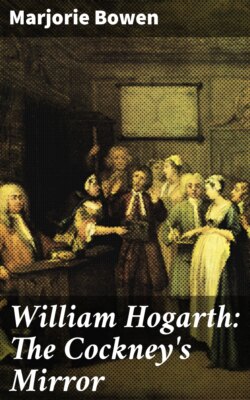Читать книгу William Hogarth: The Cockney's Mirror - Bowen Marjorie - Страница 19
На сайте Литреса книга снята с продажи.
* * *
ОглавлениеTable of Contents
Vauxhall was an older place of entertainment than Ranelagh; as early as the reign of Charles II, Sir Samuel Moreland had, on this spot (the south side of the Thames, in Lambeth), a curious hall lined with looking-glass, having on the roof a Punchinello holding a dial and surrounded by fountains, which was much visited by strangers.
This property was bought by a Mr. Jonathan Tyers in 1730, and he proceeded to advertise it as a ridotto al fresco.
This was so successful a venture that the gardens were increased in size and beauty and considerable attractions offered to the public, who could easily reach Vauxhall by water. The season was from May to August, the cost of admission one shilling. Roubiliac's statue of Handel adorned one of the neat gravel-walks, there was a fine organ in the concert hall, and for one guinea a silver ticket entitling the bearer to admission to the season's music might be obtained.
In fine weather the orchestra was placed in 'an edifice of Gothic construction, of wood and plaster, richly carved and painted white and bloom colour;' this was set in a grove of trees said to be more than a century old; these outdoor concerts began at eight and, by law, ended at eleven.
A more vulgar but equally popular amusement was known as the Day-Scene or Tin Cascade.
A painting of an extensive landscape was exposed in a large timber-room and at nine o'clock in the evening a bell was rung, upon which the curious of both sexes 'flocked in a rapid crowd' to witness an 'eye trap.'
This was a moving picture; a landscape in perspective with a mill and a miller's house was displayed and the water was seen flowing down a slope, turning the wheel of the mill, 'rising in foam at the bottom and gliding away.' A realistic sound of falling water helped the trick, which was shown for about a quarter of an hour.
The concerts usually ended with glees or catches, in which the audiences joined; refreshments were served at little tables under the trees and royalty was sheltered by a pavilion, lit by wax lights and adorned with paintings by 'the ingenious Mr. Hayman;' the subjects of these were the historical plays of Shakespeare.
Two thousand glass lamps lit the groves and walks, and bad weather was provided against by a Rotunda, a choice mixture of Gothic and Ionic styles, which was lined with mirrors, lit by chandeliers and adorned with 'bustos of eminent persons.'
The acoustics of this building, nicknamed 'the umbrella,' were excellent; it had fourteen sash-windows and a number of statues—a complete Olympus in plaster of Paris.
The outdoor walks were paved with clinkers brought specially from Holland, so that no 'gravel nor sand should stick to the feet of the company;' these paths led round several alcoves decorated with paintings, some, later in the century, from designs by Hogarth himself (four afterwards painted by himself as the Four Times of Day), others from sketches by the popular and energetic Mr. Hayman.
Some of the subjects were ordinary enough, others were lively and topical.
The New River Head was after Hogarth's design (Evening), probably painted by Hayman; it was described as:
'A family going a walking, a cow a milking, and the horns fixed archly over the husband's head.'
Two others depicted scenes from Pamela, there was another from The Merry Wives of Windsor, one from Molière's Le Médecin malgré lui (The Mock Doctor), and a brisk study entitled 'A Sea Engagement between the Spaniard and the Moars' [sic] (Battle of Lepants) [sic]; others showed fashionable pastimes, leap-frog, blindman's buff, sliding on the ice, quadrille, kite flying, card houses, tea-drinking, shuttlecock, hunting the whistle, cricket, see-saws, hot cockles, bob-cherry, and playing on bagpipes and hautboys.
Sometimes these genre pictures were given a peculiar point, as in those entitled:
The Salisbury Coach overturned, etc. (Hogarth's 'Night').
The Wapping Landlady and the Tars who are just come Ashore.
The Play of Skittles and the Husband Upbraided by his Wife, who Breaks his Skin with one of the Pins.
The Bad Family, with the Parson coming in to make Peace, the Husband with the Tongs lifted up, etc.
The Good Family, the Husband Reading, the Wife and Children Listening, the Maid Washing dishes, etc.
An Old Gypsy telling Fortunes by a Coffee Cup.
One piece had the charming title:
A Northern Chief with his Princess and her favourite Swan, placed in a sledge and drawn on the Ice by a Horse.
There was also Fairies Dancing on the Green by Moonlight, and patriotic pieces were added from time to time—Black-eyed Susan taking Leave of Sweet William on board one of Fleet in the Downs, in 1740 The Taking of Porto Bello, in 1742 The Capture of the San Josef by Captain Tucker in The Fowey, and in 1761 The Taking of Montreal by General Amherst.
